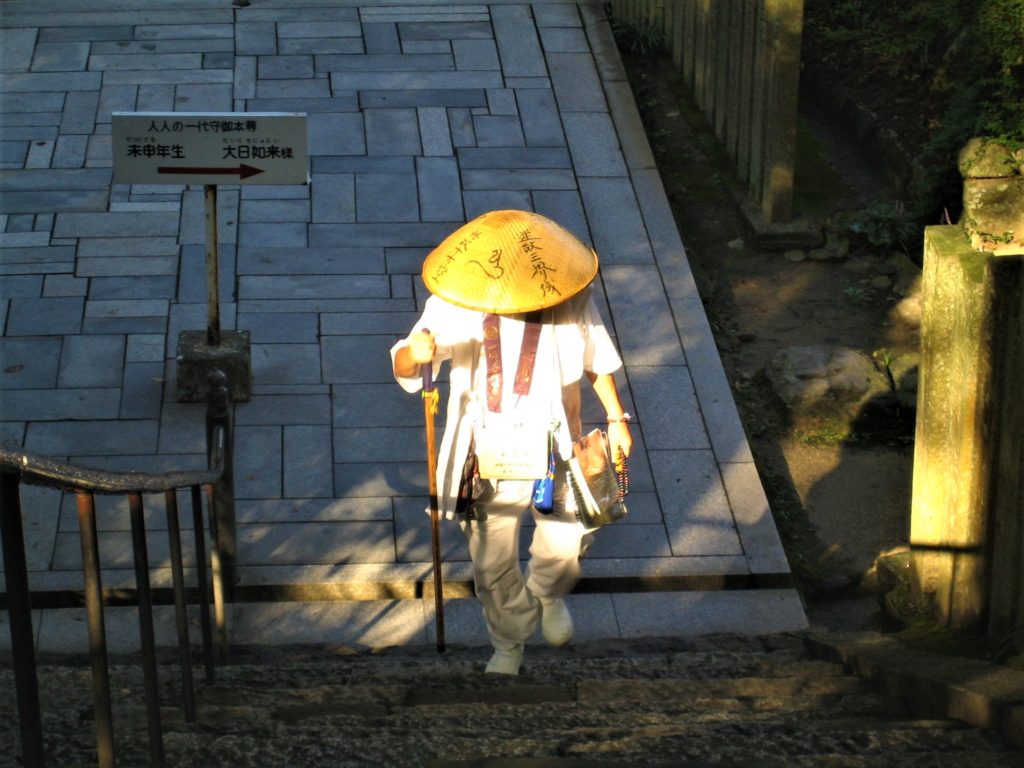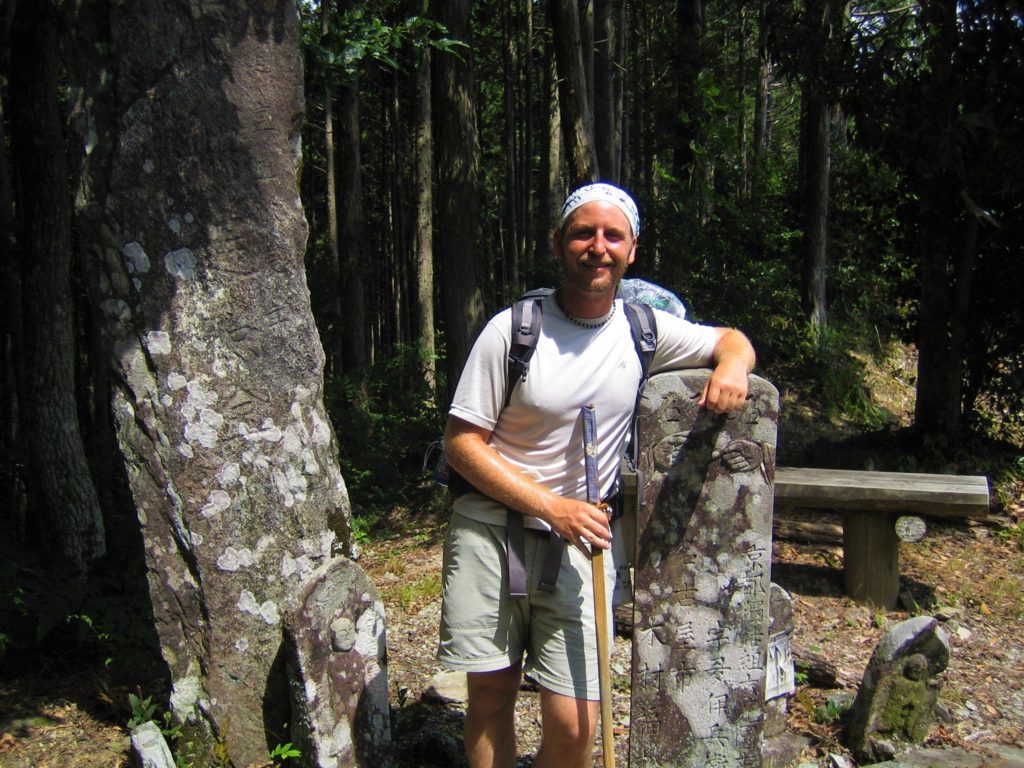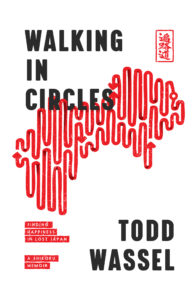
By Todd Wassel
On a humid summer morning in 2005, Todd Wassel is about to enter the forest. He is a henro (pilgrim) on a 750-mile pilgrimage to the 88 Temples of Shikoku. This excerpt from his book Walking in Circles starts from Temple 11 where the pilgrimage path plunges into dense forest then scrambles over three steep peaks to Temple 12. But the long day’s hike is the least of his worries…
Shōsan-ji, Temple of the Burning Mountain, and I have something of a troubled past. Sitting 2,300 smug feet above the Yoshino River valley, Temple Twelve is the first of six nansho (perilous places) that pilgrims visit, meant to prevent the corrupt of heart from continuing. With steep rises, exposed ridges, and no help along the way, the path up to this troublesome temple has caused countless failed pilgrimages. Modern times have made the path a safer place, especially with the advent of the cell phone for emergency calls and the various pilgrimage associations helping to keep it maintained on a regular basis. I had no cell phone.
 The walking path leaves the city of Tokushima behind and plunges into the backcountry over three peaks, lined with the graves of fallen henro. Japan is home to 46 species of snakes, but it was not the long, green ones I was most wary of. The source of most pilgrims’ worry was a one-foot, gray killer, the mamushi. A pit viper, it was a constant threat to my sanity as well as to the lives of thousands of farmers all over Shikoku. Usually found in early morning and at dusk, the venom is enough to kill if not treated immediately.
The walking path leaves the city of Tokushima behind and plunges into the backcountry over three peaks, lined with the graves of fallen henro. Japan is home to 46 species of snakes, but it was not the long, green ones I was most wary of. The source of most pilgrims’ worry was a one-foot, gray killer, the mamushi. A pit viper, it was a constant threat to my sanity as well as to the lives of thousands of farmers all over Shikoku. Usually found in early morning and at dusk, the venom is enough to kill if not treated immediately.
Heeding the warnings of the old men the night before, I came prepared and wore my snake guards—two pieces of coarse, thick, dirty cotton wrapped around my ankles—to protect me from the deadly, but dentally challenged, killer.
To get to Temple Twelve you must first pass through Temple Eleven, Fujii-dera, where I was now, sitting outside a public telephone booth working up the courage to call ahead. Learning my lesson from yesterday, I wanted to make a plan for the night. I took out the list of free accommodation I received at Temple One and found the phone number for Temple Twelve listed. I was hesitant to call, given the misunderstanding I had with the temple’s monk seven years ago. It was a careless mistake I made, showing up at dusk and asking to camp in my tent on the temple grounds without any warning. I was a new pilgrim and didn’t know all of the rules, but they weren’t thrilled with me. Even so, they found a way to help me. I’m sure it was because I showed up without calling and caused them distress. The list clearly indicated to call first to arrange a place to sleep.
I spoke into a lime green public phone at Temple Eleven, conveniently located near the path into the mountains. “Excuse me,” I said. “I’m a walking henro. May I please stay at your tsuyadō tonight?”
A tsuyadō is a free place to sleep along the henro path. It comes in many forms, such as a simple wooden gazebo, country barn, or a small prefabricated room, complete with electricity. What I was seeking for the night was the small, dirty tool shed in the middle of a plum orchard just past Temple Twelve to which I had previously been banished.
“That’s not possible,” the gruff voice on the other end said in Japanese.
“Ah, I see.” I tried again. “I’m sorry, I must not have explained myself well enough. It’s just that I have a long climb to reach your temple and no place to sleep tonight. I was hoping to sleep in the tsuyadō.”
“There is no tsuyadō here.”
Hmm. I switched tactics and began waving the list of free places as if the man could see it. “That’s strange,” I said, “because I’m looking at a list of tsuyadō I received at Ryōzen-ji and it lists your temple,” I added, leaving him some room to backtrack. “It even says to call first to confirm.”
“No! There is no tsuyadō here.”
Maybe we were having a language problem. “I see. Well perhaps you don’t call it a tsuyadō. I’d like to sleep in the tool shed in the orchard. I slept there when I walked the pilgrimage last time.” I congratulated myself on remaining calm. Although, I did fantasize about jumping through the phone and beating some sense into him with the receiver.
“No, there’s nothing like that here,” he repeated with more than a touch of annoyance.
“Well, it’s just that I have no place to sleep and . . .”
Loud beeps cut me off. He had hung up.
I replaced the phone in shock and with not a little bit of anger. The temple staff had been just as rude seven years ago. I had assumed their sourness was because I had not called first. It seemed that just made things worse.
I wasn’t sure what else I could have done. Maybe I should have ignored the advice on the sheet, shown up at dusk, and brought a picture of the tool shed as proof. No doubt he still would have denied the existence of the tsuyadō.

Most likely it was my fault. I had assumed that reality and appearance were the same, and in Japan, they rarely ever are, and insisting they are is considered rude. He had a reason for saying no, for denying the existence of the tsuyadō. It didn’t matter if it was there or not. The fact that there was a free place to stay for walking pilgrims ceased to exist the moment he denied it. Reasoning with him was not going to change things.
I should have stopped asking. I should have realized that, for whatever reason, this man did not want me to stay the night. Maybe he was new and did not know about the tsuyadō. Or he was worried a foreigner wouldn’t know how to act in a Japanese tool shed. I might not take off my shoes or might fall asleep spooning the rice scythe. What a mess that would be to clean up in the morning.
I needed to learn to let things go. I did accept, although begrudgingly, that I wouldn’t have a roof over my head that night. One of the rules I had decided to honor before walking the pilgrimage was that I would accept a refusal of help and move on without complaint. In this instance that meant cursing the temple and its staff in my mind, rather than calling back or trying to convince them in another way. Perhaps this is how people react internally in Japan. Behind stoic faces, deep bows, and profuse expressions of apology, they rant and rave and curse the other party to the lower levels of Buddhist hell. More likely, I was just being petty.
The repetitive beeping of the public telephone reminded me not to forget my phone card. The phone card, a present from the monk at Temple Eleven, in turn reminded me that there were still plenty of generous people out there. In fact, it was an example of osettai, or charitable offerings, the practice of which is unique to Shikoku, compared to the rest of Japan. Osettai is practiced all along the pilgrims’ path where locals give henro presents. Anything works, including money, food and drinks, directions, a kind word, or free lodging.
Pilgrims have to receive all offerings with a thank you and a name slip given in return. The slips, filled in with your name, date, and hometown, are the same ones left at each temple, and residents believe they are talismans of good luck (omamori) for those who receive them. Before each henro sets out, they usually buy hundreds of them to have enough to last the journey. The more times a pilgrim completes the circuit, the greater the power of the slip. Most name slips left in temple bins and given out are white, indicating the henro has completed one to four pilgrimages. Green slips are used for those who have done more than five circuits, and red for those who have completed seven to twenty-four journeys. Silver or bronze slips indicate up to 49 trips, while gold signifies 50 to 100. Finally, there are multicolored slips called nishiki. Made from woven fabric, they represent those who have managed to complete more than 100 pilgrimages.
Osettai is based on the belief that henro occupy a spiritual realm and are closer to Kūkai than the average person. The giver receives karma associated with helping someone complete the pilgrimage, and the name slip, bearing my name and prayers, becomes the vehicle for this spiritual boon.
For me, osettai was a constant reminder of people’s goodness. On more than one occasion, the simplest of gestures lifted me from the deepest of depressions. The telephone card reminded me that temple staff really did care about pilgrims; I was just being petty and should let Temple Twelve go.
About the Author
Todd Wassel is an international development professional, author and traveler. Visit his blog The Fermented Word.

